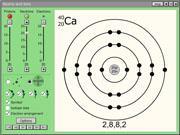Neil Dixon reviews this electronic package
Sunflower for science CD-ROM (8 chemistry programs) and teacher's handbook
Sunflower Learning
Thames Ditton: Sunflower Learning 2005 | £846.00 for site licence for eight programs

Sunflower for science is an electronic package of interactive animations to support Key Stage 3 and 4 biology, chemistry and physics. You can run the program from the CD-ROM or copy the files to your hard drive without having to install any new software. The resource can be easily networked or installed on individual terminals for student use. The software comes cross-referenced to the 2006 GCSE specifications and is accompanied by a comprehensive guide, which has screen-shots to help teachers get going.
There are three interfaces for the content. Examples can be used by the teacher as a demonstration, using a digital projector. Activities can be used by students and teachers who would benefit from some support on screen to guide them through the interactive content. However, I think the main strength of the suite is the Worksheets option. This opens up an electronic worksheet which prompts students to interact with the animations and type their answers on screen. The worksheet can only be printed when the student has typed in his or her name. Each worksheet is available in three differentiated levels. The worksheets cannot, however, be saved as Word documents. They can be stored and then later restored, but only the most recent half-completed worksheet can be restored, which is often impractical. There is no automatic marking and feedback facility which would be very useful, especially on the multiple choice questions.
The eight chemistry programs cover the topics atoms and ions, bonding, diffusion, dissolving, elements compounds and mixtures, the Periodic Table, rates of reaction, and states of matter. On the whole, the interactive and animated content is of high technical and educational quality. Highlights include the bonding topic, in which atoms and electrons can be dragged around to show ionic and covalent bonding, and the three dimensional Periodic Table, which can be rotated to show different periodic trends. However, I was concerned by the particle diagrams of solids and liquids which had particles too widely spaced, suggesting that liquids should be compressible. This could lead to student misconceptions that would be severely penalised in Key Stage 3 SATs.
Sunflower for science is a high-quality resource which will be popular with the vast majority of KS3 and KS4 teachers. The package represents excellent value for money because individual topics can be bought separately and can be used in a variety of different ways with students.






No comments yet